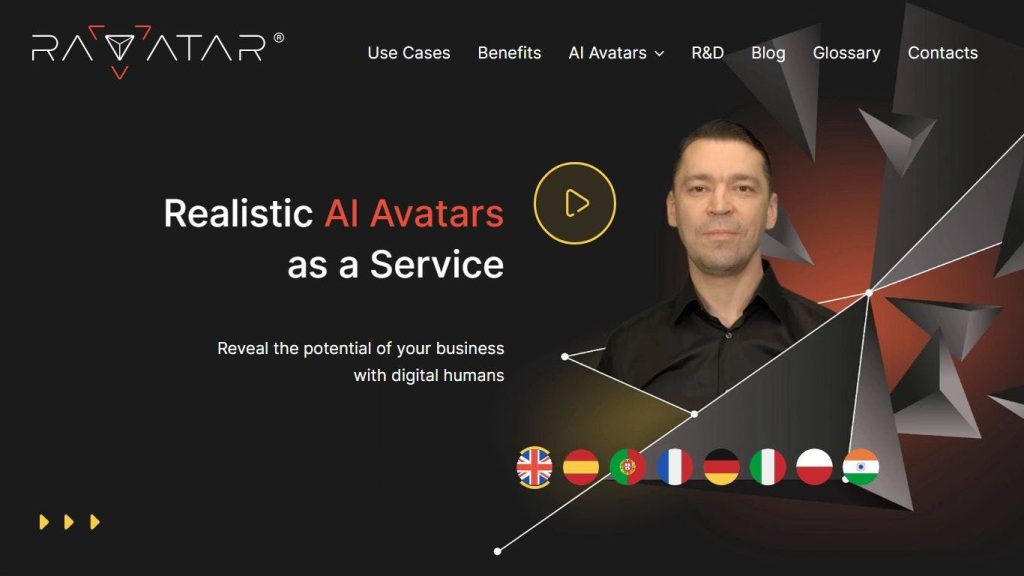What is RAVATAR?
RAVATAR is a state-of-the-art AI tool that generates high-quality, realistic human avatars by using advanced generative AI technologies. Applying the power of synthetic data, it would be possible for RAVATAR to re-create any human being in virtual reality by collecting existing audio and video samples. Such technology will not only simulate human behavior and appearance but also open a wide range of applications—from improving customer experiences in sales and support to emulation of well-known personalities for virtual events and on to developing holographic avatars for enhanced interaction.
Letter “R” in RAVATAR stands for three major concepts:
-
Realistic:
Avatars of AI resemble human look and behavior in a Virtual Real Estate. -
Revolution:
Avatars of AI are revolutionizing the way in which humans communicate, tearing down cultural barriers. -
Resurrection:
Ability to create replicas of deceased individuals as AI avatars from their personal data and past interactions.
RAVATAR’s Key Features & Benefits
Various features are combined in RAVATAR, making the tool quite attractive for a wide class of users. Some of the key features and their respective benefits are listed below:
-
Avatar Generation:
A life-like avatar can be created using this application, which looks like any real or fictional character. -
Realistic Human Appearance:
The Avatar will be able to mimic all the minute expressions and gestures of humans, hence sounding more realistic in the interaction. -
Synthetic Data Processing:
Specialized technologies are employed to process and reconstruct human behavior. -
Human Behavior Replication:
Can be made to act or respond like humans themselves to give a more interactive experience. -
Versatile Use Cases:
Can be put into use in many situations that range from personal to professional.
These features confer a number of advantages, including enhanced customer service, cost reduction, and valuable feedback on customer behavior and preference. Businesses can keep the edge over their competitors, and individuals can have new forms of interaction and memory preservation.
RAVATAR: Use Cases and Applications
RAVATAR is versatile and finds applications across various industries and sectors, including:
-
Customer-Facing Interactions:
Boost sales and support interactions with the help of realistic avatars. -
Virtual Events:
Double public figures to create virtual event hosts for virtual events and live TV shows. -
Holographic Avatars:
Create next-level interactions by using life-like holographic representations.
Industries that can take the benefit of RAVATAR include marketing, graphic design, game development, movie production, and advertising. Business case studies are witnesses that customer satisfaction and engagement have surely increased due to RAVATAR.
How to Use RAVATAR
RAVATAR usage is easy and very basic. The following will explain in detail how one can get started with using RAVATAR.
-
Sign Up:
The first thing that one needs to do is to sign up on the RAVATAR platform. -
Upload Data:
Upload audio and video material to create the Avatar. -
Configure:
Customize the appearance and behavior of the avatar as desired. -
Integrate:
Integrate the avatar into a system or platform of your choice.
For optimal output, ensure that audio and video samples are of high quality. Second, play more with the UI to see other options of customizing and go through the detailed instructions provided by RAVATAR for smooth integration.
How RAVATAR Works
RAVATAR is powered by the latest generative AI and conversational AI technologies. Some of the technologies that back it up include:
-
Generative AI:
Through this technology, machine learning algorithms ensure effective creation of human Avatars from synthetic data. -
Natural Language Processing:
This helps avatars listen to humans and subsequently answer them accordingly. -
Speech Generation:
Generates voice responses that sound natural.
The workflow encompasses everything from data collection and processing to avatar generation and deployment. This covers an end-to-end process where avatars could resemble human behaviors and appearances with a great view of realism.
RAVATAR Pros and Cons
Like any other technology, RAVATAR bears its own share of merits and demerits:
Pros:
- Realistic avatars to a great extent.
- Wide usage.
- Engages more customers.
- Cost-effective solutions.
Cons:
- Relies on high-quality data.
- Potential ethical concerns in using the data of the deceased.
User feedback has generally been positive, focusing on how the tool helps in improving interactions and engagement.
Conclusion about RAVATAR
RAVATAR is a powerful tool that provides all such facilities for the development of realistic human avatars. From features to benefits, it covers a wide number of use cases that may serve various purposes. Having advanced technology, versatile use cases, and positive user feedback, it is one of the most valued assets from the perspective of both businesses and individuals. Its future development and updates are sure to make it more special, and thus, it becomes one of the most worth-watching tools.
RAVATAR FAQs
-
What kind of data would one need to build an avatar?
Production of realistic avatars using good quality audio and video samples are required. -
Can RAVATAR reproduce any person?
Yes, because RAVATAR can recreate real and fictional characters based on the given input. -
What about the ethical issue of RAVATAR?
Since it is ethically sensitive to imagine recreating dead persons’ input as Avatars using RAVATAR, it’s something that needs to be viewed with extreme care. -
How can RAVATAR be used for business benefits by companies?
With this, businesses can increase consumer interaction, create less expense, and have better insight into customer behavior and preferences.










